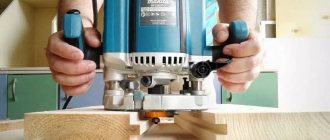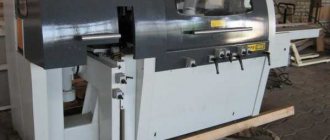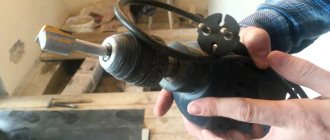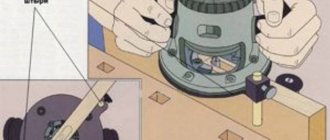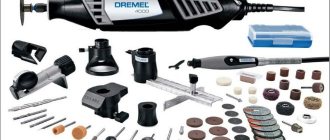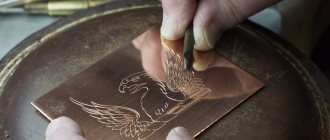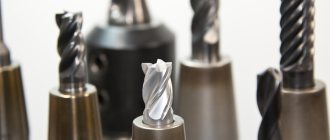A manual milling machine in the hands of a master has a universal application - with its help you can create both basic household items and masterpieces of artistic processing for decoration. However, to use it correctly, you need a suitable cutting tool. Let's look at what types of cutters there are, how they are designed, what their main purpose is, what criteria they are classified by, and how to choose the right one for a specific type of wood processing.
An example of using a wood cutter on a manual machine Source prosto-instrumenty.ru
Wood cutter for a manual router - what is it and what is its purpose
A cutter for a manual electric router is a small-sized cutting tool. Consists of three simple parts:
- shank;
- supporting body;
- cutting knives fixed in the supporting body.
A lot depends on the quality of the cutter. As experienced craftsmen say, it is not so important what kind of router is used, what matters is the quality of the cutter.
However, it is better to work with a high-quality, convenient router. During operation, the cutter rotates at enormous speeds, due to which cleanliness, speed and quality of processing are achieved. The electric motor of the milling cutter, through an overdrive gearbox, gives the cutter a rotation speed from 10,000 to 30,000 rpm. The more revolutions the router can produce, the better.
Type of shank diameter
The shank of a cutter is a round metal rod, the same as that of a drill. But unlike a drill press, drill or screwdriver, the cutter shank is clamped not in a 3-jaw chuck, but in a collet clamp (collet).
This clamp is much more compact than the chuck; it is easier to tighten one nut than the jaws on the chuck with a special wrench. This is important given the design of this tool. The disadvantage of this clamp is that you can only use shanks that are suitable in size. This differs from a chuck, in which you can clamp the shank of a drill with a size of, for example, from 1 to 10 mm.
Modern routers use collets to clamp three main shank standards: 6 mm, 8 mm, 10 mm and 12 mm. Many models come with replaceable collets. For example, for 6 and 8 mm shanks.
The cutter rotates at enormous speeds, so it must always be securely tightened when working. If the collet clamp fails, you cannot use the tool, it is dangerous.
The collet is tightened with a special wrench included in the kit or with another spanner (open-end) wrench of similar size. To tighten and unscrew, the shaft is locked either by pressing the lock provided in the design, or with another key, if the shaft has edges for a second key for fixing.
Fixation with a second key is more reliable, since the internal latches sometimes break off. Therefore, on high-quality branded models, key fasteners are often used. This is an advantage, not a disadvantage.
The collet nut is tightened with force until it stops, but without unnecessary zeal, so as not to strip the threads, or the edges of the nut and the key.
Video description
Video instructions for choosing wood cutters for a beginner:
The ends of the workpieces to be joined are given a specific profile using a specific type of cutter. They are then connected by locking into a single, durable structure. The procedure is performed without additional adjustment of the selected surfaces, since the complete tools are perfectly matched to each other.
Curvy
The figuere type cutters are intended for forming panels. Example - baseboards, furniture doors, decorative strips, etc. As a rule, the tool is quite massive, and therefore machines with a power of 1.6 kW or more are used to process workpieces with it. In this case, cutters are divided into three categories:
- Horizontal. Create a panel.
- Double-sided. A panel and tenon are formed.
- Vertical. Used for selecting the profile of skirting boards.
On a note! By itself, even a good hand router and correctly selected cutters for the type of wood processing do not guarantee the planned result. For quality work, you will need a set of suitable stops and templates.
Main types of structures
Without exaggeration, hundreds of milling cutters of various purposes, profiles and designs are offered on the modern market. By design, there are three main groups of this cutting tool.
Prefabricated
The simplest and most common type. It consists of a shank, a supporting body and cutting knives attached to it. All three parts are made of different alloys. The knives are made of special cutting steel, everything else is made of cheaper metals. They are called prefabricated because different parts are assembled during production. Further, it is impossible to disassemble or assemble the elements of such equipment; everything is tightly secured.
Some profiles are equipped with bearings that can be removed.
Monolithic
This is practically the same equipment as the three-piece prefabricated ones described above. Nothing changes or is rearranged. The difference from the prefabricated version is that the entire cutter is made of the same alloy. In another way, such cutters are called backed ones.
With replaceable cutting edges
Such designs allow you to remove or rearrange individual cutting elements, obtaining the desired cutting profile. As an example, in the image below there is a groove/tenon cutter.
When using two cutting edges, a tenon-shaped cut is obtained. If you unscrew the nut, remove one cutting element and adjust the height of the cutter to the desired size, you can get a groove for this tenon.
The same type includes cutters with double-sided knives. They are not tightly fixed in the case, but are screwed on. When one side becomes dull, the knives are turned over and the other side is used.
An example of such equipment:
Shell cutters with replaceable knives are also used on stationary milling machines. This is a drum for attaching knives, similar to those found on conventional electric planes. But instead of the usual flat ones, figured knives with different profiles can be inserted into it.
Classification of cutters by shank size, type of design and cutting part
Cutting tools for a manual milling machine are classified primarily according to the following three criteria:
- Tail dimensions.
- Type of construction – prefabricated, replaceable blades, monolithic, attachment/set-on.
- Material and method of sharpening the cutting edge.
Let's look at these parameters in more detail.
Set of cutters for woodworking Source instrumentgid.ru
Tail dimensions
In the characteristics of the tail section, the unit of diameter is of paramount importance. The designation must coincide with a similar parameter of the collet - the place where the cutter is mounted in the machine. As a rule, there are only two standards for this value:
- Millimeter. The most common sizes are 6, 8 and 12 mm.
- Inch. There are two main types - half and quarter inches, denoted - ½ and ¼, respectively.
When comparing two measurement systems, it turns out that products with similar diameters differ only by a small amount in size. Thus, 6 mm and ¼ or 6.35 mm cutters and 12 mm and ½ or 12.7 mm cutters look almost the same - however, the holder of a hand router is not adapted to securely hold any type of tool, like a drill chuck.
Therefore, a 12 mm cutter loaded into a ½-inch collet will not sit securely in the chuck and can easily fly out during processing. Likewise, if you load a ½-inch tool into a 12-mm holder, it may jam so much that you will have to come and repair the machine later.
The packaging indicates the size and other main parameters of the cutters Source goods.ru
The second important characteristic is the length of the shank. However, often when choosing the right tool in terms of shape, design, diameter and other parameters, it turns out that it is impossible to find one suitable for the processing conditions of the required length. In this case, special extension adapters come to the rescue.
It should also be remembered that such “helpers” should be used as a last resort and with caution. Since under loads, speeds and revolutions characteristic of modern machines, such a device will always have the property of a “weak link”.
Important! Metric and imperial cutting attachments are not interchangeable. And their use in this capacity can lead not only to damage to the workpiece or machine, but also risks injury to the operator.
See also: Catalog of companies that specialize in garden furniture and storage systems
Type of construction – prefabricated, replaceable blades, monolithic, attachment/set-on
According to the design features of wood cutters, there are 4 main types:
- Prefabricated. It is made by soldering, using refractory solders, the cutting edge to a monolithic base - the shank and the head. They are distinguished by simplicity and accessibility of production.
Example of a prefabricated cylindrical cutter Source atis-market.com
- With replaceable blades. The cutting edge is a separate element, fixed to the head with screws and which the user can replace or sharpen as necessary. Some products have up to 4 working surfaces - which significantly increases the working life of the tool.
- Monolithic. The cutting part is formed directly on the base itself - by analogy with a drill. The advantage is the minimal risk of blade tearing off. However, for prolonged use it must be periodically sharpened, which over time changes the original geometry, impairs performance and leads to the need for replacement.
- Mounted/set-on. The cutting head is connected to the shank in a movable manner. This allows you to change the distance between elements and their sequence for more varied processing of workpieces.
Recommendation! To gain experience and become familiar with processing techniques, a novice user only needs to purchase prefabricated cutters. For the more experienced and professional, kit tools are the best option.
Milling cutter with replaceable blades Source prostanki.com
Material and method of sharpening the cutting edge
The large number of revolutions and the resulting high temperature in the processing zone force tool developers to use the following 2 types of metal alloys as cutting edge materials for wood cutters for hand routers:
- Tool steel. It is marked - HSS. Designed for processing low-density wood at maximum speeds. Disadvantage: when it gets into a denser environment, the cutting edge instantly becomes dull. Therefore, it is not suitable for cutting chipboard, MDF and other similar materials.
- Carbide brazing. Designated - NM. Used for processing dense wood at medium and low speeds. Can also be used for finishing machining with high cutting edge quality. However, it is often impossible to achieve the ideal degree of smoothness when finishing with an average cutter of this type.
Frame cutters with carbide-tipped blades Source zubr-rus.ru
Types of cutter blades
The shape of the profile of the cutting edge (blades) of the cutter determines what kind of sample will be obtained in the end. There are several main types.
Grooved
The purpose corresponds to the name - equipment for making grooves. In turn, there are varieties of groove cutters.
End groove
“End” means that the sampling is performed not only by the side, but also by the end part (lower end) or only by the end part. Example in the image below:
Such cutters can be of different diameters. There are options with a bearing located at the top for making a groove (rebate or quarter) on the side of the workpiece.
Slotted structural with side cutting edge
This cutter can be used in different ways. So, as shown above, along a full profile, or to make a simple straight groove on the side of the workpiece to the desired depth, set using a rip fence.
Fillet groove cutters make a groove with a semicircular groove
This is the main cutter for applying decorative patterns and surface wood carvings. With its help, you can apply drawings and patterns both along the intended lines and using a compass or patterns.
We also recommend reading an interesting article about artistic carving with a jigsaw.
Edge
Designed for processing side edges. Their main difference is the presence of a ball bearing at the bottom of the shank. This makes work simple and convenient. The bearing prevents the cutter from going deep inside and damaging the workpiece; it rotates along the surface of the workpiece, making the tool move easily and smoothly.
The edges are processed with a variety of profiles. Therefore, cutters of this type may include slotted, figured (profile), tenon, rebated cutters for selecting quarters and other cutters with bearings.
If necessary, the bearing can be removed and the cutter can be used in another way. For example, for sampling a profile in the middle of a workpiece after a fillet or simple direct sampling, setting the desired depth. In this case, preliminary selection is necessary, since edge cutters with bearings are not end cutters; they do not have knives at the very end, at the bottom end.
Combined
Combined cutters are called cutters for a “complex groove/tenon” connection. The peculiarity of this connection is that the joined edges have the same groove, and not a groove and tenon, as on the lining. You can see what such cutters and connections look like in the following video:
This image also well illustrates the capabilities of such equipment:
If a groove/tenon connection (like a lining or tongue-and-groove floor plank) requires passage with two different profiles (groove and tenon), then a combined cutter makes a compatible connection on both sides.
Curvy
These are large cutters with different complex profiles, a combination of wide semicircles, rounded grooves, etc. The result of their work can be seen on paneled doors (the panel is selected with them) and curly baseboards.
Of course, long-length moldings (the same as skirting boards) are made not with hand milling machines, but with powerful milling machines. But small amounts of work - several doors, 10-30 running meters. skirting boards can also be made using a hand router with a power of at least 1.5 kW. To cut moldings, a hand router is sometimes secured in the table upside down (with the cutter facing up).
An example of a classic figurine cutter specifically for a manual router in the image:
The next image shows a more complex double (double-leaf) figurine cutter.
In one pass, she makes not only a door or furniture panel, but also a tenon for fastening it into the groove of an adjacent part.
Other types
A special type of cutter is Forstner drill. By design these are cutters. But since they perform the function of a drill, that is, they make round holes, they are called both cutters and drills. Their functional difference from classic spiral drills with a conical tip is the following - they form a flat, rather than conical, bottom of a non-through hole. This is often important. For example, when planting round elements of furniture fastenings, hinges, etc.
The image shows a Forstner drill:
Forstner drills are available in a wide range of diameters, from 10 mm to 56 mm, sometimes more, both individually and in sets. The cutting element consists of three main parts:
- Scoring lateral incisors. Due to them, the edges of the holes do not tear, the hole is drilled cleanly.
- The lower incisors are strictly perpendicular to the axis of rotation. Therefore, the bottom of the hole is smooth.
- The third element, centering the peak in the middle, allows you to accurately orient the drill along the mark; when entering the workpiece, it does not jump or move.
Carbide cutters with tungsten carbide or other metals make it possible to use such equipment for drilling chipboard, MDF and other materials with hard adhesive resins, which is important in the manufacture of cabinet furniture from such materials.
A separate type includes cutters for soft metals, plastics and other non-wooden materials. As a rule, knives made of harder alloys are used for such cutters.
Milling cutter for a manual wood router - what is it, device, purpose
A milling cutter is the main tool with which wood is processed. The scope of application, purpose, and result depend on its technical characteristics. Despite the fact that there are many varieties of it in terms of shape and features of the cutting edge, materials and other parameters, they are all united by the general principle of the device and the presence of standard parts:
- The cutting area, also called the head or working part. It can have different geometry, composition and blade design.
- Shank - serves as a support for the previous element. With its help, the tool is clamped in the machine chuck, and torque is also transmitted to the main part.
- Additional component. It is located on the very edge of the instrument - opposite the tail section. This could be a support bearing, locking couplings, screws, washers, calibration bushings and other devices. Their task is to simplify or expand the functionality of the cutter, for example, to arrange the cutting segments in the required sequence or to process the workpiece according to a given pattern.
Diagram of an end mill with designation of characteristics Source infradom.ru
Depending on the scope and purpose, modern wood cutters for a manual router allow you to solve the following types of problems:
- Forming edges. It is used when it is necessary to create parts of workpieces that are combined into one structure using a tongue-and-groove connection.
- Creation of cut-outs for installation of fittings.
- Production of decorative forms, cuttings, configurations.
Advice! Certain types of work require your own set of cutting tools. Therefore, before selecting specific types of cutters, it is necessary to determine what the nature, type and volume of wood processing work performed with their help will be.
Popular manufacturers
Milling cutter manufacturers today can be divided into two groups:
- milling cutter manufacturers who produce accessories for their power tools and compatible tools from other manufacturers;
- manufacturers of cutting equipment who specialize in this and do not produce power tools themselves.
The former produce products of fairly good quality, since they are interested in ensuring that their instrument works successfully. But they are not interested in their equipment working forever so that sales are not one-time. From time to time, such cutters are replaced with new ones.
The most widespread and popular manufacturers are Encore, Bosch, Fit, Corvette and others.
The latter try to maintain a reputation for the quality of their products and produce professional products with a long service life. However, among them there may be “nameless” products of poor quality of unknown origin.
How to choose
The quality and durability of a cutter can only be determined through actual work. It is impossible to do this by inspection or other means before purchasing. If you need to buy a large set of different profiles for a significant amount, you can check the quality without lengthy work in the following way:
- buy one cutter from the selected manufacturer;
- the reverse side of the cutting edge is trial sharpened with an ordinary file with a fine notch;
- if sawdust is removed, the alloy is not strong enough. (Easy to sharpen, easy to dull).
It is not worth buying a large number of cutters of this quality. Carbide edges are sharpened only with abrasive wheels of sharpening machines or diamond needle files; a regular file will not take them.
Signs of a low-quality or dull cutter - the profile is not completely selected. The tool moves with force, the wood turns black and burns until smoke appears.
A brand's reputation can give an idea of quality. Most brands produce “mass consumer goods” for household use, but the quality is good enough to do the job required.
The cutters of the above brands - Bosch, Enkor, Fit, etc. - have average and sufficient quality for work.
Price is not always an indicator of quality. The fact is that the price depends not only on the expensive or cheap alloys used, the cost of the equipment, but also on the profile of the cutter. A complex profile of a larger size costs more than a simple one.
Good cutters are produced by German manufacturers. Quality guarantee if the product is not manufactured, for example, “in the PRC under control, etc.,” but specifically in Germany. Therefore, when searching in online stores, you should click on country-. The results will only include products manufactured in this country.
German cutters are perfectly balanced, do not create vibrations or beats at high speeds, process wood as cleanly as possible and retain their working qualities for a very long time without sharpening.
Is it possible to do it yourself?
Despite their apparent simplicity, the production of these products requires advanced, high-precision and high-tech equipment. The cutter should be:
- ideally balanced in weight so that there are no eccentric beats at high speeds;
- the profiles of the knives and their location must repeat each other with high accuracy, up to hundredths of a mm;
- cutting edges (knives) must be made of hard alloys, which can only be profiled and sharpened with an even more durable tool.
For these reasons, it is almost impossible to make a cutter yourself without equipment. The exception is simple straight knives on equipment with replaceable blades. In theory, you can cut the desired size from, for example, planer knives. But even here there are problems with balancing the weight and drilling holes for fastenings in solid metal.
In a home workshop you can sharpen some types of profiles. This is done from the back side of the cutting edge, since it is impossible to do this on a curved profile from the side of the tip, sharpened at an angle.
Sharpening is carried out with a flat diamond file. But it’s more effective on a sharpening machine, a thin or bowl-shaped wheel that fits into the niche of the cutter and reaches the surface to be sharpened.
Severe overheating during sharpening is unacceptable, as this will change the factory characteristics of hardening (heat treatment) of the metal. Sharpening is carried out until a small chamfer appears on the reverse side. Then the chamfer is carefully removed with zero-grit sandpaper, using light movements so as not to dull the tip.
Basic parameters and classification
The parameters according to which drill cutters intended for wood processing are divided into different categories are:
- main purpose;
- dimensions;
- the shape of the cutting part;
- design features;
- manufacturing material.
Basic geometric parameters of wood cutters
Types by purpose
Today, many tools are used to perform milling work on wood using an electric drill, since technological operations with this material can be different. Depending on the main purpose, the following types of wood cutters are distinguished.
Mouldings
Using such a tool, the corners of wood products are rounded.
V-shaped
These cutters are used to cut V-shaped grooves on flat wood surfaces. Using such a tool, you can make various patterns and inscriptions on the product, as well as process edges.
Groove
cutters Disc These are wood cutters, with the help of which grooves and grooves of various widths and depths are cut on the surface of the workpiece.
Folded
Such cutters are similar in purpose to disk cutters, but they allow you to create wider grooves on the surface of the product. Cutters of this particular type are used in window production, where they are used to cut grooves in wooden frames to accommodate glass.
Fillet
Using cutters of this type, semicircular grooves can be created at the end of the workpiece. Wood fillet cutters equipped with a support bearing are used for the manufacture of decorative furniture slats.
Spiked
These are tools with a cutting part made in the shape of a reverse cone. With their help, you can create dovetail grooves in wood products. It is these grooves that are used to create open and hidden tenon joints between two or more parts made of wood.
Edge (quarter)
These wood cutters are designed for processing the edges of wooden products. The design of the edge cutter may contain a bearing, which, resting against the edge of the workpiece, ensures its correct position and limits the depth of its cut.
Edge cutters
Cylindrical
wood cutters of this type can be manufactured with straight or helical cutting edges. Using such tools, flat surfaces are processed.
End
These cutters are also designed for flat surface processing. Unlike cylindrical ones, they have cutting teeth on the end part.
Conical
Using these cutters, chamfers are removed from the edges of the workpiece. Such a wood cutter, used for installation on a drill, can also have a thrust bearing in its design, which limits the depth of the tool’s cut into the wood.
End
These wood cutters are used to create complex grooves and recesses on the surface of the workpiece.
Shaped
These are cutters used to form elements with a complex configuration on the surface of a wood product.
Shaping cutters
Types by design
Milling tools used in conjunction with drills can have different designs. Thus, there are solid and prefabricated wood cutters, which should also be selected depending on the characteristics of the material to be processed.
Solid-type cutters are made from one steel billet, respectively, their body and cutting part are made of the same grade of metal. Such tools are inexpensive, but they can be used for processing materials that are not too hard. Naturally, the working life of this type of cutter is small.
Solid cutters made of tool steel
More wear-resistant and durable are prefabricated wood cutters, the body of which is made of ordinary steel. Their cutting teeth are carbide plates that are fixed to the body of the tool by soldering and are not sharpened during operation. With the help of such cutters it is possible to process harder materials with high productivity.
Wood cutters with carbide cutters
Regardless of the type of wood cutters for a drill, their cutting teeth can be pointed or backed. In the first, the front and back surfaces are flat, and their sharpening is carried out along the back surface. The big disadvantage of milling cutters with cutting teeth of this type is that when they are sharpened, the geometric parameters of the tool, in particular its diameter, can change. Milling cutters with backed teeth, in which only the front surface is flat, do not have such a disadvantage. Since sharpening of such a tool is carried out precisely along the front surface, this procedure can be carried out repeatedly without worrying that the geometric parameters of the cutter will change.
How to store
The cutters do not require any special storage conditions. Avoid ingress of water, preferably a dry room to avoid rust. Otherwise, each master stores them in the way that is most convenient.
Complete cutters are sold and stored in boxes. Purchased individually, they can be placed on a board with holes drilled for the shanks. When cutters are needed frequently, they are kept on hand. In other cases, they put it away so as not to interfere.
A hand router is a multi-functional tool with the widest capabilities. First, problems are set that need to be solved. Why is a cutter with a suitable profile selected for their implementation? Beginners should know that a router is not a magic wand that will do everything on its own. This tool needs to be worked. And then all the possibilities that a router with a suitable cutter gives to every master will open up.


